This document provides an overview of arrays and linked lists as data structures. It discusses arrays, including declaration, initialization, updating elements, and multi-dimensional arrays. It also covers searching arrays, why arrays are needed, pros and cons of arrays, and character strings as arrays. The document then introduces linked lists as a data structure and discusses linked list operations like printing all elements, adding nodes, appending nodes, inserting nodes, and deleting nodes. Homework questions on arrays and linked lists are provided at the end.
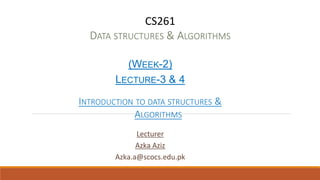



![Array
Array name is reference to memory location where first elment of array is stored
Array elmements can be accessed using array name and a non-negative integer index e.g.
say records is an array then records[2] refers to 3rd elment of array
Index values for an N element array range from 0 to N-1
Array elements can be accessed randomly (no sequence is required to follow for it)
0 1 2 3 4 5 6 7 8 9](https://image.slidesharecdn.com/dsweek2-221130190953-3b8f129d/85/Data-structure-pptx-5-320.jpg)
![Array Declaration
Syntax : datatype anArrayname[sizeofArray];
int data[10];
As the result of above statement execution an integer array of ten elements is
created within the memory of computer
First valid index is 0 and last valid index is 9
Array elements can be refered as data[0], data[1], data[2], … , data[9]
0 1 2 3 4 5 6 7 8 9](https://image.slidesharecdn.com/dsweek2-221130190953-3b8f129d/85/Data-structure-pptx-6-320.jpg)
![Array initialization
Syntax : datatype anArrayname[sizeofArray]= {comma separated
values};
int data[10]={5, 3, 12, 23, 8, 37, 6, 10, 55, 4};
As the result of above statement execution an integer array of ten elements is
created within the memory of computer and are initialized with provided values
0 index value is initialized with 5, 1 index value is initialized with 3, 2 index value
is initialized with 12 so on and so forth
5 3 12 23 8 37 6 10 55 4
0 1 2 3 4 5 6 7 8 9
Elements
Indexes](https://image.slidesharecdn.com/dsweek2-221130190953-3b8f129d/85/Data-structure-pptx-7-320.jpg)
![Array initialization
int data[5];
data[0]=6; data[1]=12; data[2]=18; data[3]=24; data[4]=30;
As the result of first statement execution an integer array of ten elements is created
within the memory of computer. Statements in second line are initializing array
elements:
6
12
18
24
30
0
1
2
3
4
index
Array values](https://image.slidesharecdn.com/dsweek2-221130190953-3b8f129d/85/Data-structure-pptx-8-320.jpg)
![Array … first program
#include <iostream>
int main(int argc, char** argv) {
int values[10]={5, 10, 3, 18, 7, 12, 34, 26, 0, 47};
for(int i=0; i<10; i++)
std::cout<<values[i]<<std::endl;
return 0;
}
A simple program that initializes a ten element integer
array and prints all elements using for loop](https://image.slidesharecdn.com/dsweek2-221130190953-3b8f129d/85/Data-structure-pptx-9-320.jpg)
![Array … Updating elements
array[index] = new-value;
A declared array element can be assigned a valid value during within the scope of
array. See below:
#include <iostream>
int main(int argc, char** argv) {
int values[10]={1,2,3,4,5,6,7,8,9,10};
values[2]=20; values[4]=30; values[9]=11;
return 0;
}](https://image.slidesharecdn.com/dsweek2-221130190953-3b8f129d/85/Data-structure-pptx-10-320.jpg)


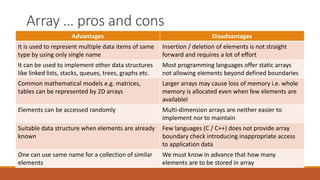
![character string as array
In C/C++ strings are treated like as an array of characters e.g.
char message[]=“welcome”;
Above character is stored in memory like:
w e l c o m e 0
Every string is terminated by a null character ‘0’](https://image.slidesharecdn.com/dsweek2-221130190953-3b8f129d/85/Data-structure-pptx-14-320.jpg)
![character string as array …
If we initialize a character array with a size e.g.
char message[12] = “welcome”;
Then memory actually looks like:
Last four characters spaces are unused.
w e l c o m e 0](https://image.slidesharecdn.com/dsweek2-221130190953-3b8f129d/85/Data-structure-pptx-15-320.jpg)
![character string as array …
We can actually access individual elements of a character array:
char message[]=“welcome”;
std:cout<<message[3]<<std:endl;
Output:
c](https://image.slidesharecdn.com/dsweek2-221130190953-3b8f129d/85/Data-structure-pptx-16-320.jpg)
![character string as array …
Creating a string as character array requires at compile time how many character
will be stored in it. Such arrays are called static arrays. Examples below:
char message[]=“message”; // eight characters will be allocated for this array
char country[20]=“Pakistan”; // nine chracters will be allocated for this array](https://image.slidesharecdn.com/dsweek2-221130190953-3b8f129d/85/Data-structure-pptx-17-320.jpg)
![Array name AND pointer
Array name is a pointer and it points to initial position of memory allocated to store
array contents. It can be assigned to a character pointer type of variable and that in
return can access array contents like original array name. Example below:
char message[]="welcome";
char *pointer=message;
std::cout<<pointer[3]<<std::endl;](https://image.slidesharecdn.com/dsweek2-221130190953-3b8f129d/85/Data-structure-pptx-18-320.jpg)
![Multi-dimensional arrays
C/C++ allows multi-dimensional arrays. Following is the syntax for declaring them:
datatype array_name[dim1][dim2]….[dimN];
A typical two dimensional integer array can be declared as:
int arr[5][4];
This 2D array can be imagined as a table and can be visualized as:
arr[0][0] arr[0][1] arr[0][2] arr[0][3]
arr[1][0] arr[1][1] arr[1][2] arr[1][3]
arr[2][0] arr[2][1] arr[2][2] arr[2][3]
arr[3][0] arr[3][1] arr[3][2] arr[3][3]
arr[4][0] arr[4][1] arr[4][2] arr[4][3]
Row 0
Row 1
Row 2
Row 3
Row 4
Col 0 Col 3
Col 2
Col 1](https://image.slidesharecdn.com/dsweek2-221130190953-3b8f129d/85/Data-structure-pptx-19-320.jpg)
![Multi-dimensional arrays
A multi-dimensional array can be initialized by specifying each row values separated
by commas as below:
int arr[2][3]={{1,2,3}, {1,2,3}};
1 2 3
1 2 3](https://image.slidesharecdn.com/dsweek2-221130190953-3b8f129d/85/Data-structure-pptx-20-320.jpg)



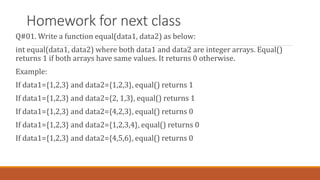


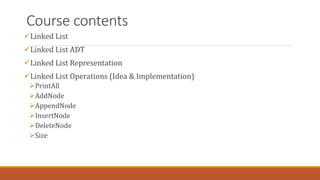



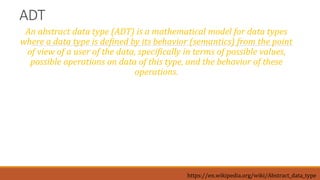


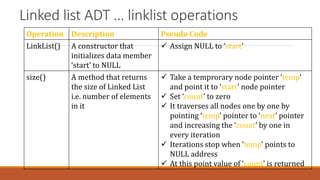

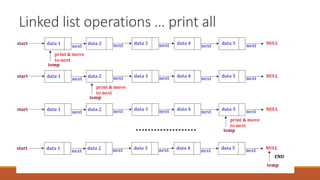




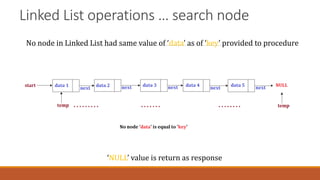
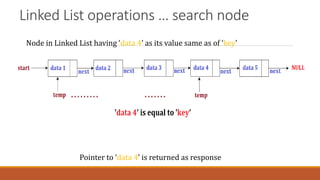



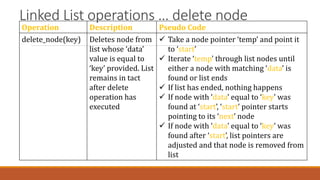











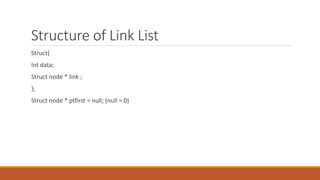
![Main Algorithm
Start
Repeat (loop) while true (true = 1)
[menu option]
Write(cout) (“1: Insert ”);
Write (“2: display ”);
Write (“3: Insert first ”);
Write (“4: Insert after ”);
Write (“5: Insert before ”);
Write (“6: Delete ”);
Write (“7: Exite ”);
Write (“Enter option number ”);
Read (cin) option number (option_number)
Select option_number
It include switch case
Option 1
Write (“ Insert value ”);
Read value
Insert (value)
Option 2](https://image.slidesharecdn.com/dsweek2-221130190953-3b8f129d/85/Data-structure-pptx-59-320.jpg)
![Insert (value)
[check for empty list]
If ptfirst == NULL ; then
Temp = new node ;
Temp -> link = ptfirst;
Ptfirst = temp;
Else
Ptfirst = temp ;
Repeat while loop (temp != NULL)
Temp = temp -> link;
[End of loop of step 2a]
Temp-> link = new node ;
Temp = temp -> link ;
[End of if-else structure ]
Temp -> data = value;
Temp -> link = NULL;](https://image.slidesharecdn.com/dsweek2-221130190953-3b8f129d/85/Data-structure-pptx-60-320.jpg)
![Display();
if ptfirst == NULL then
write(“list is empty”);
return
[End of if structure ]
temp = ptfist;
repeat while (temp != NULL)
◦ write (temp -> data)
◦ Temp -> temp -> link ;
[End of loop]
return ;
Algorithm for inset first
Insert first(value)
[creat a new node ]
Temp = new node;
Temp -> data = value;
Temp -> link = ptfirst;
Ptfirst = temp;
Return;](https://image.slidesharecdn.com/dsweek2-221130190953-3b8f129d/85/Data-structure-pptx-61-320.jpg)